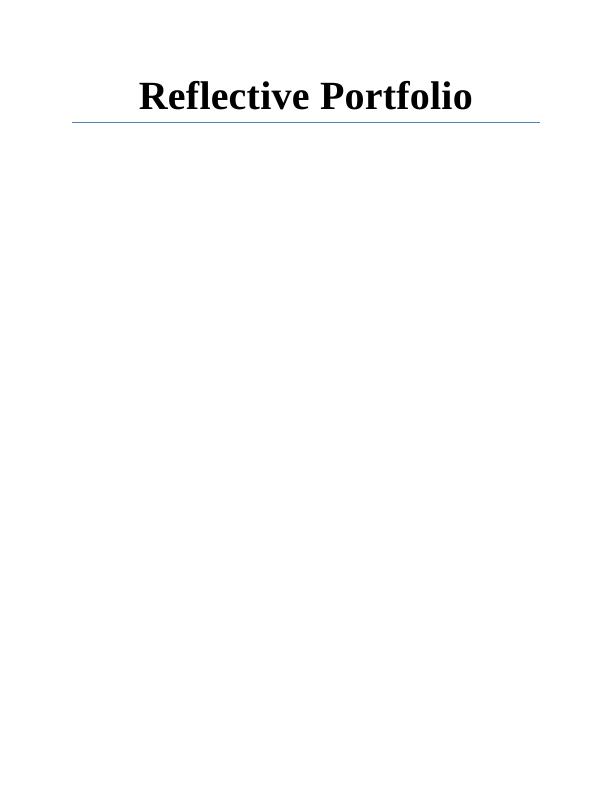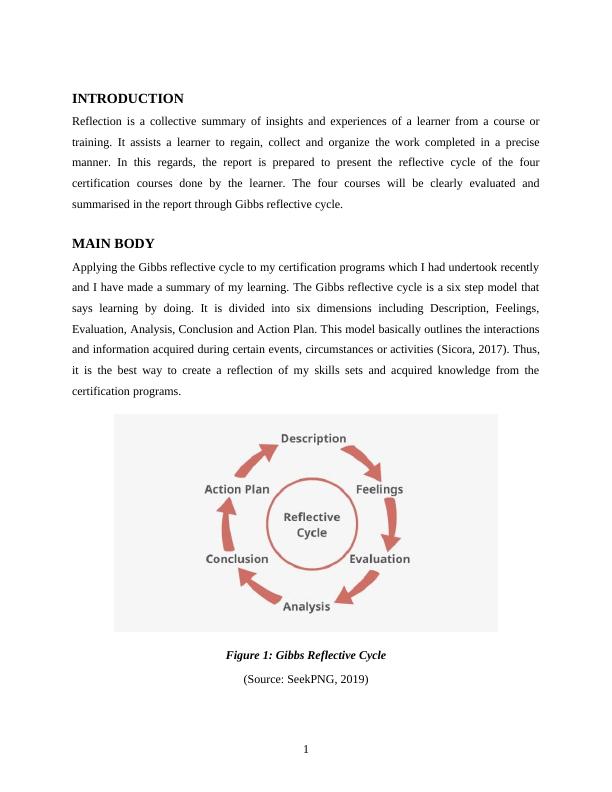Reflective Portfolio Analysis 2022
Added on 2022-08-24
13 Pages2663 Words45 Views
Reflective Portfolio

TABLE OF CONTENTS
INTRODUCTION...........................................................................................................................1
MAIN BODY..................................................................................................................................1
Stage 1: Description.....................................................................................................................2
Stage 2: Feelings..........................................................................................................................2
Stage 3: Evaluation......................................................................................................................3
Stage 4: Analysis.........................................................................................................................4
Stage 5: Conclusion.....................................................................................................................5
Stage 6: Action Plan....................................................................................................................5
CONCLUSION................................................................................................................................6
REFERENCES................................................................................................................................7
APPENDIX......................................................................................................................................8
INTRODUCTION...........................................................................................................................1
MAIN BODY..................................................................................................................................1
Stage 1: Description.....................................................................................................................2
Stage 2: Feelings..........................................................................................................................2
Stage 3: Evaluation......................................................................................................................3
Stage 4: Analysis.........................................................................................................................4
Stage 5: Conclusion.....................................................................................................................5
Stage 6: Action Plan....................................................................................................................5
CONCLUSION................................................................................................................................6
REFERENCES................................................................................................................................7
APPENDIX......................................................................................................................................8

INTRODUCTION
Reflection is a collective summary of insights and experiences of a learner from a course or
training. It assists a learner to regain, collect and organize the work completed in a precise
manner. In this regards, the report is prepared to present the reflective cycle of the four
certification courses done by the learner. The four courses will be clearly evaluated and
summarised in the report through Gibbs reflective cycle.
MAIN BODY
Applying the Gibbs reflective cycle to my certification programs which I had undertook recently
and I have made a summary of my learning. The Gibbs reflective cycle is a six step model that
says learning by doing. It is divided into six dimensions including Description, Feelings,
Evaluation, Analysis, Conclusion and Action Plan. This model basically outlines the interactions
and information acquired during certain events, circumstances or activities (Sicora, 2017). Thus,
it is the best way to create a reflection of my skills sets and acquired knowledge from the
certification programs.
Figure 1: Gibbs Reflective Cycle
(Source: SeekPNG, 2019)
1
Reflection is a collective summary of insights and experiences of a learner from a course or
training. It assists a learner to regain, collect and organize the work completed in a precise
manner. In this regards, the report is prepared to present the reflective cycle of the four
certification courses done by the learner. The four courses will be clearly evaluated and
summarised in the report through Gibbs reflective cycle.
MAIN BODY
Applying the Gibbs reflective cycle to my certification programs which I had undertook recently
and I have made a summary of my learning. The Gibbs reflective cycle is a six step model that
says learning by doing. It is divided into six dimensions including Description, Feelings,
Evaluation, Analysis, Conclusion and Action Plan. This model basically outlines the interactions
and information acquired during certain events, circumstances or activities (Sicora, 2017). Thus,
it is the best way to create a reflection of my skills sets and acquired knowledge from the
certification programs.
Figure 1: Gibbs Reflective Cycle
(Source: SeekPNG, 2019)
1

Stage 1: Description
This stage is the description of initial experience of a learner that defines the positive and
negative aspects of particular event or situation. It also defines the things that went well and the
things that didn’t. Also, the learner can describe the outcome of activity and the expected
outcome (Sicora, 2017). In the recent period I have been through four certification programs
including Google Forms Essential Training, SPSS Academic Testing, EndNote Essential
Training and Learning Office 365. Every program I attended brought a positive experience for
me and added to my skills set in a very pleasant mode. SPPSS course taught the leading software
and its uses for running academic research to interpret data from quantitative tests. It included t-
tests, variance analyses, and statistical measurements for the academic researches. On the other
hand, Goggle forms is the program that is quick and simple method of creaking online surveys
for taking responses from the recipients in an easy and efficient approach. Next I attended
Learning Office 365, a cloud based productivity suite that taught to organise my data and work
by using the applications of 365. Also, the EndNote essential training was necessary to save my
efforts and time wasted on referencing. The platform is a source to manage the tedious period of
creating citations and looking of authentic sources.
For the mentioned courses I attended online programs organised by LinkedIn Learning and got
certificates for each. These courses were chosen by me on the basis of my current qualification
and future profession. Therefore, I might through my abilities stand out from the crowd. Also, I
had many confusing things going on in my mind during the initial phase but later on realised that
I had to create some personal sections according to the term and coming chapters in the program.
Gradually, I made modules as per each section in program and created objectives for myself.
Then I learned that the idea of creating goals for me was the motivation factor that added to my
learning. Since, I had some friends who were doing same course I asked them about their
planning and learning. Those conversations helped me to understand the learning clearer.
Stage 2: Feelings
In the entire term of any kind of program or activity getting frustrated or irritated and it’s just
normal at times. Most of individuals are not very comfortable at the beginning due some events
or situations throughout the period (Oham, Pestano and Allen, 2016). Thus, the second phase of
reflective cycle explains the emotions, feelings and attitude of an individual during and after the
2
This stage is the description of initial experience of a learner that defines the positive and
negative aspects of particular event or situation. It also defines the things that went well and the
things that didn’t. Also, the learner can describe the outcome of activity and the expected
outcome (Sicora, 2017). In the recent period I have been through four certification programs
including Google Forms Essential Training, SPSS Academic Testing, EndNote Essential
Training and Learning Office 365. Every program I attended brought a positive experience for
me and added to my skills set in a very pleasant mode. SPPSS course taught the leading software
and its uses for running academic research to interpret data from quantitative tests. It included t-
tests, variance analyses, and statistical measurements for the academic researches. On the other
hand, Goggle forms is the program that is quick and simple method of creaking online surveys
for taking responses from the recipients in an easy and efficient approach. Next I attended
Learning Office 365, a cloud based productivity suite that taught to organise my data and work
by using the applications of 365. Also, the EndNote essential training was necessary to save my
efforts and time wasted on referencing. The platform is a source to manage the tedious period of
creating citations and looking of authentic sources.
For the mentioned courses I attended online programs organised by LinkedIn Learning and got
certificates for each. These courses were chosen by me on the basis of my current qualification
and future profession. Therefore, I might through my abilities stand out from the crowd. Also, I
had many confusing things going on in my mind during the initial phase but later on realised that
I had to create some personal sections according to the term and coming chapters in the program.
Gradually, I made modules as per each section in program and created objectives for myself.
Then I learned that the idea of creating goals for me was the motivation factor that added to my
learning. Since, I had some friends who were doing same course I asked them about their
planning and learning. Those conversations helped me to understand the learning clearer.
Stage 2: Feelings
In the entire term of any kind of program or activity getting frustrated or irritated and it’s just
normal at times. Most of individuals are not very comfortable at the beginning due some events
or situations throughout the period (Oham, Pestano and Allen, 2016). Thus, the second phase of
reflective cycle explains the emotions, feelings and attitude of an individual during and after the
2

End of preview
Want to access all the pages? Upload your documents or become a member.
Related Documents
My personal growth have been evaluatedlg...
|13
|2559
|26
Is reflective practice ethical? (The case of the reflective portfolio)lg...
|11
|2610
|42
Reflective Writing on LFBM202 Work-Based Learning Modulelg...
|11
|3117
|286
Reflective Model of Gibbs for Professional Developmentlg...
|9
|2090
|476
Reflective Research Projectlg...
|8
|2115
|37
Reflective Portfolio on Linkedin Learning Assignment 2022lg...
|12
|2381
|30
